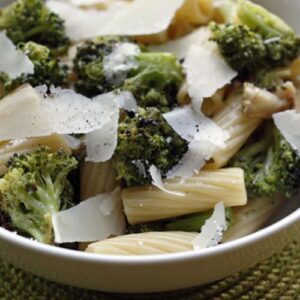
Roasted Broccoli Pasta
A simple yet flavorful pasta combining roasted broccoli, smashed garlic, and extra virgin olive oil. This fiber-rich, protein-packed dish is ready in just 30 minutes — a healthy, satisfying choice for weeknight dinners or easy meal prep.
Equipment
- 1 large baking dish
- 1-Large pot
- 1 colander or strainer
- Measuring cups
- Measuring Spoons
- Wooden spoon or spatula
Ingredients
- 8 oz pasta your choice of type
- 1½ lbs broccoli florets
- 6 –8 cloves garlic smashed
- 2 tbsp extra virgin olive oil
- Kosher salt to taste
- Freshly ground black pepper to taste
- ¼ cup freshly grated Pecorino Romano
Instructions
- Preheat the Oven: Begin by preheating your oven to 450°F (232°C). This ensures the broccoli roasts evenly and develops a slightly caramelized, nutty flavor. A fully preheated oven helps achieve crisp edges while keeping the florets tender inside, which is essential for the final texture and taste of this dish.
- Prepare the Broccoli and Garlic: Wash and dry 1½ pounds of broccoli florets thoroughly. Pat them dry with a clean kitchen towel or paper towels to remove excess moisture, which helps the broccoli roast instead of steam. Smash 6 to 8 cloves of garlic gently with the flat side of a knife — this releases aroma without overpowering the dish. Keeping the garlic whole allows it to roast slowly and add a subtle, sweet flavor.
- Season and Toss Broccoli: Place the broccoli florets and smashed garlic cloves in a large baking dish. Drizzle evenly with 2 tablespoons of extra virgin olive oil. Sprinkle kosher salt and freshly ground black pepper generously over the broccoli and garlic. Toss everything thoroughly using clean hands or a spatula to ensure all pieces are coated evenly in oil and seasoning. This step is crucial for flavor and even roasting.
- Roast the Broccoli: Spread the broccoli and garlic in a single layer to ensure even cooking. Place the baking dish in the preheated oven and roast for about 20 minutes. At the halfway point (around 10 minutes), carefully remove the dish and toss the broccoli to promote uniform browning. Continue roasting until the florets are tender with golden, crisp edges. This roasting process enhances sweetness and depth of flavor.
- Prepare the Pasta Water: While the broccoli is roasting, fill a large pot with water and add a generous pinch of kosher salt. Bring it to a rolling boil over high heat. Salting the water seasons the pasta from within and slightly improves its texture. Boiling the water first ensures pasta cooks evenly.
- Cook the Pasta: Once the water is boiling, add 8 ounces of pasta. Stir occasionally to prevent sticking. Cook according to package directions until al dente — firm but tender. Taste a piece of pasta a minute before the suggested time to ensure perfect texture. Cooking pasta to the correct doneness is key for this dish.
- Reserve Pasta Water: Before draining, scoop out and set aside 1 cup of pasta cooking water. This starchy liquid will help create a silky sauce that binds the pasta and broccoli together beautifully. Having this step ensures your dish stays moist and flavorful rather than dry.
- Combine Pasta and Broccoli: Drain the pasta in a colander and return it to the pot or a large mixing bowl. Add the roasted broccoli and smashed garlic directly to the pasta. Toss gently so the pasta absorbs the flavors from the roasted vegetables. This step allows the textures and aromas to blend before creating the final sauce.
- Create the Sauce: Pour ½ cup of the reserved pasta water over the pasta and broccoli mixture. Add ¼ cup of freshly grated Pecorino Romano cheese and toss thoroughly. The cheese will melt and combine with the starchy pasta water, coating the pasta in a rich, velvety sauce. If the pasta appears dry, add more reserved pasta water until the desired consistency is achieved.
- Final Seasoning and Serving: Taste and adjust seasoning with additional kosher salt and freshly ground black pepper as needed. Serve immediately while warm, garnished with extra Pecorino Romano if desired. This pasta is best enjoyed fresh to preserve the texture of the roasted broccoli and the creaminess of the cheese sauce.
Notes
- Use fresh broccoli for the best flavor and texture — frozen broccoli tends to be softer and less crisp when roasted.
- Smashing garlic cloves instead of chopping them allows for a milder roasted flavor and avoids overpowering the dish.
- Reserve pasta water carefully — it’s the secret to making a silky, cohesive sauce.
- Pecorino Romano adds a salty, tangy depth, but Parmesan can be substituted if needed.
- For extra flavor, add a pinch of red pepper flakes while tossing the pasta.